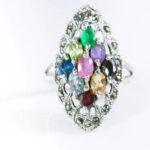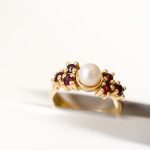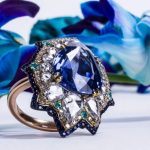Are you interested in learning how to start beading jewelry? Beading has become increasingly popular in the fashion industry as more people seek unique and personalized jewelry pieces. This introductory section will provide you with an overview of the world of beading jewelry, including the basics, design inspiration, essential techniques, and finishing touches to help you get started on your beading journey.
As you dive into the world of beading jewelry, it’s essential to understand the basics of beads, materials, and tools needed for your projects. From there, finding inspiration for your designs and understanding how to get started with your first project are key aspects that will set a strong foundation for your journey into beading.
Whether you’re a beginner or have some experience with beading, this article will guide you through the essential techniques and provide tips and tricks to troubleshoot common issues. Additionally, we’ll explore how to professionally finish your beaded jewelry pieces and where to go next to further enhance your skills and connect with other like-minded individuals in the beading community.
Understanding the Basics
When it comes to beading jewelry, it is essential to understand the basics of the craft before diving into your first project. To start creating beautiful beaded jewelry pieces, you will need to familiarize yourself with the different types of beads, materials, and tools that are commonly used in this art form.
Types of Beads
There is a wide variety of beads available for beading jewelry, including glass beads, crystal beads, seed beads, gemstone beads, metal beads, and more. Each type of bead offers its unique characteristics and can add a special touch to your jewelry designs. It’s important to explore these options and understand how they can complement each other in your creations.
Materials and Tools
In addition to beads, you will also need various materials and tools to get started with beading jewelry. Some essential materials include beading wire or thread, clasps, findings, and bead boards. As for tools, you’ll need items such as pliers, wire cutters, bead needles, and crimpers. Understanding how these materials and tools work together will set a solid foundation for your beading journey.
Exploring Options
As you begin learning about the basics of beading jewelry, take the time to explore different options for beads, materials, and tools. Visit local craft stores or online suppliers to see what’s available and start building your collection. By understanding the range of choices at your disposal, you can better plan out your first few projects and prepare yourself for a successful start in beading jewelry.
Learning about the different types of beads, materials required for beading jewellery as well as the appropriate tools is crucial when initiating into this creative pursuit. By having a good grasp of these elements beforehand ensures all necessary resources are within reach when creating personalized pieces or engaging in intricate designs.
Inspiration and Design
When it comes to creating beaded jewelry, the possibilities are endless. Whether you’re a beginner or an experienced beader, finding design inspirations is essential for creating unique and personalized pieces. One way to find inspiration is by exploring different cultures and traditions that use beaded jewelry as a form of adornment. African, Native American, and Indian cultures are just a few examples of rich traditions that incorporate beading into their jewelry.
Another source of inspiration can come from nature itself. The colors, shapes, and textures found in nature can serve as a great starting point for designing your beaded jewelry pieces. From ocean-inspired designs using shells and pearls to earthy tones using natural wood beads, the natural world offers an abundance of design ideas.
In addition to cultural influences and nature, you can also look to current fashion trends for inspiration. Keep an eye on what’s popular in the fashion industry and adapt those trends into your beaded jewelry designs. Whether it’s incorporating geometric shapes, bold colors, or mixing metals with beads, staying current with fashion trends can help keep your designs fresh and appealing.
| Inspiration Source | Examples |
|---|---|
| Cultural Influences | African tribal patterns, Native American beadwork |
| Nature | Ocean-inspired designs using shells and pearls, earthy tones using natural wood beads |
| Fashion Trends | Geometric shapes, bold colors, mixing metals with beads |
Exploring various sources of inspiration will allow you to create one-of-a-kind pieces that reflect your personal style while staying relevant in the ever-changing world of fashion. The key is to keep an open mind and let your creativity flow when it comes to designing beaded jewelry.
Ultimately every piece should carry a bit of your personality through each detail on it.
Getting Started
When starting your journey into the world of beading jewelry, it’s important to have a clear understanding of the basics. This includes knowing the different types of beads, materials, and tools needed to begin your first project. Whether you’re interested in creating delicate bracelets, statement necklaces, or intricate earrings, choosing the right beads, strings, and findings is crucial to achieving your desired design.
Choosing the Right Beads
Before diving into your first beading project, take some time to explore the wide variety of beads available in the market. From glass beads and gemstones to seed beads and pearls, each type offers its unique characteristics and aesthetic appeal. Consider factors such as color, size, shape, texture, and finish when selecting beads for your project.
Selecting Quality Strings and Findings
In addition to choosing the right beads for your beading project, it’s equally essential to select quality strings and findings. The string you choose will depend on the weight and type of beads you’re using. For beginners, flexible and durable options such as nylon-coated steel wire or beading thread are recommended. Furthermore, findings such as clasps and jump rings are essential for securing your jewelry pieces together.
Tips for Finding Inspiration
Once you have a good grasp of the types of beads, strings, and findings available in the market, it’s time to find inspiration for your first beading project. Look for design inspirations in fashion magazines, online platforms like Pinterest or Instagram, or even nature itself. Observing various jewelry designs can help fuel your creativity and guide you in making unique personalized pieces.
By understanding how to choose the right beads, strings, and findings for your first beading project, you’ll set yourself up for a successful start in creating beautiful jewelry pieces. Remember that experimentation is key to finding what works best for you.
Essential Techniques
When it comes to beading jewelry, mastering essential techniques is crucial in creating beautiful and professional-looking pieces. Whether you are a beginner or looking to improve your skills, learning the basics of stringing, wiring, and knotting will help you take your beading projects to the next level.
- Stringing: One of the most fundamental techniques in beading jewelry is stringing beads. This involves using different types of threads or wires to create a base for your beaded jewelry. Some popular stringing materials include nylon thread, silk cord, and stainless steel wire. When starting a stringing project, it’s important to consider the weight of your beads and the durability of your chosen stringing material.
- Wiring: Another essential technique in beading jewelry is wiring. This involves using metal wire to create intricate designs and patterns within your jewelry pieces. With wiring, you can create loops, spirals, and other decorative elements that add complexity and visual interest to your designs. It’s important to choose the right gauge of wire for your project, as well as learn basic wireworking techniques such as making simple loops and wrapped loops.
- Knotting: Knotting is a versatile technique that can add texture and dimension to your beaded jewelry pieces. Whether you’re creating knotted bracelets or incorporating knots within necklace designs, understanding different knotting techniques will enhance the overall look of your jewelry. Popular knotting techniques include overhand knots, square knots, and surgeon’s knots.
Understanding these essential techniques will give you the foundational knowledge needed to start beading jewelry with confidence and creativity. By practicing these skills and experimenting with different materials and designs, you’ll soon be on your way to creating unique and personalized jewelry pieces that reflect your style and personality.
Tips and Tricks
When starting to bead jewelry, it’s important to be prepared for common issues that may arise during the creative process. Here are some helpful pro tips on how to troubleshoot these issues and create professional-looking jewelry:
- Use the right tools: Ensure you have the proper tools for beading, such as needle-nose pliers, wire cutters, and crimping pliers. Using the correct tools will make your beading process much smoother and help avoid any unnecessary issues.
- Organize your beads: Keeping your beads organized will not only save you time but also prevent any mix-ups or confusion when working on your jewelry pieces. Consider using a bead organizer or small containers to keep your beads separated and easy to access.
- Practice precision: When creating beaded jewelry, precision is key. Make sure to measure and cut your stringing material accurately to avoid any tangling or uneven lengths in your finished piece.
In addition to troubleshooting common issues, there are also techniques that can help elevate your beaded jewelry pieces to a professional level:
- Experiment with different materials: Don’t limit yourself to traditional beads – consider incorporating gemstones, crystals, or even metal components into your designs. This can add an extra layer of sophistication and uniqueness to your jewelry.
- Pay attention to detail: Small details such as properly finishing off the ends of your jewelry with clasps or closures can make a huge difference in the overall appearance of your piece. Take the time to ensure everything is neatly finished for a polished look.
- Seek feedback: Don’t be afraid to seek feedback from peers or mentors in the beading community. Constructive criticism can help you identify areas for improvement and take your skills to the next level.
By following these pro tips, you can troubleshoot common beading issues and create professional-looking jewelry that reflects your unique style and creativity. Remember that practice makes perfect, so don’t get discouraged if things don’t go smoothly at first – with time and dedication, you’ll soon become a skilled beader.
Finishing Touches
Once you have completed your beaded jewelry piece, the next step is to add the finishing touches that will elevate your creation to a professional level. One of the most important aspects of finishing your beaded jewelry is adding clasps and closures. These elements not only serve a functional purpose by securing your jewelry around the wearer’s neck or wrist but also contribute to the overall aesthetic of the piece.
There are various types of clasps and closures to choose from, including lobster claws, toggle clasps, magnetic closures, and more. When selecting a clasp or closure, consider both its functionality and how it complements the design of your beaded jewelry.
In addition to clasps and closures, embellishments can further enhance the visual appeal of your beaded jewelry. Adding decorative elements such as charms, pendants, or spacer beads can help personalize your creation and make it stand out. Embellishments also provide an opportunity to add a pop of color or texture to your jewelry piece. By carefully selecting and strategically placing these embellishments, you can create a truly unique and eye-catching beaded jewelry design.
When it comes to professionally finishing your beaded jewelry with clasps, closures, and embellishments, attention to detail is key. Taking the time to ensure that all components are securely attached and aligned properly will result in a polished final product. Additionally, experimenting with different combinations of clasps, closures, and embellishments will allow you to develop a signature style for your beaded jewelry creations.
| Clasps | Closures | Embellishments |
|---|---|---|
| Lobster claws | Magnetic closures | Charms |
| Toggle clasps | Spring ring clasps | Pendants |
| S-hook clasps | Box clasps | Spacer beads |
Where to Go Next
In conclusion, the world of beading jewelry is a fascinating and rewarding hobby that allows for endless creativity and personal expression. By understanding the basics of beads, materials, and tools, as well as finding inspiration in various designs, anyone can start creating their own unique pieces of jewelry.
The step-by-step guide provided in this article offers a comprehensive overview of how to choose the right supplies, master essential techniques, troubleshoot common issues, and add professional finishing touches to your beaded jewelry.
Now that you have learned the fundamentals of how to start beading jewelry, it’s time to take your skills to the next level. There are numerous resources available online such as tutorials, forums, and online communities where you can connect with other jewelry enthusiasts who share your passion for beading. Additionally, consider joining local workshops or classes to further enhance your skills, learn new techniques, and gain invaluable insights from experienced beaders.
Remember that practice makes perfect, so don’t be discouraged if your first few attempts at beading jewelry don’t turn out exactly as you envisioned. With dedication and patience, you will soon become more proficient at creating stunning beaded jewelry pieces. So go ahead and explore this wonderful hobby – who knows? You may even decide to turn your love for beading into a successful business or a meaningful way to share your creativity with others.
Frequently Asked Questions
What Do I Need to Start Making Beaded Jewelry?
To start making beaded jewelry, you will need some basic supplies such as beads, jewelry wire or string, clasps, and tools like pliers and wire cutters. Additionally, it’s helpful to have a bead board for organizing your design.
How Do You Start Beading?
Starting with beading involves selecting the type of jewelry you want to make (necklace, bracelet, earrings, etc.) and choosing the appropriate beads and materials. Then, you’ll design the pattern and layout on a bead board before stringing the beads onto wire or string and finishing with clasps.
Is Selling Beaded Jewelry Profitable?
Selling beaded jewelry can certainly be profitable, especially if your designs are unique and appeal to a specific market. With the rise of online marketplaces and craft shows, there are plenty of opportunities to sell your creations and turn a profit. However, success in selling beaded jewelry often depends on factors like quality, creativity, and marketing.

Welcome to my jewelry blog! My name is Sarah and I am the owner of this blog.
I love making jewelry and sharing my creations with others.
So whether you’re someone who loves wearing jewelry yourself or simply enjoys learning about it, be sure to check out my blog for insightful posts on everything related to this exciting topic!





